

These pictures are in reverse chronological order but that doesn't mean the best one is at the top.
Prior to March 2020 I was using my Canon DSLR and Ritchey-Chrétien telescope to image the Moon. We had some clear nights around New Moon so I decided to try this combination on M51. I had also bought an off-axis guider which enabled me to remove the second telescope and so reduce the weight carried by my mount. It all involved a steep learning code, which is illustrated below.
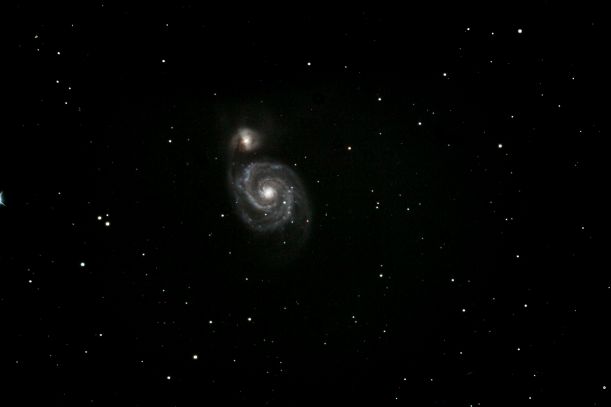
This is my first attempt using the unmodified 1100D. Ten six-minute exposures were stacked and the histogram stretched 30-255 in RegiStax. The image of M51 was very weak and it was brought out by adjusting the gamma curve as shown here.
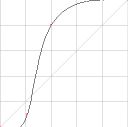 Finally the background glow was removed using the colour balance tool in PhotoImpact.
Finally the background glow was removed using the colour balance tool in PhotoImpact.
Date and Time: 19th April 2020 22:40 to 23:36:37 UT
Camera: Canon 1100D
Telescope: 8-inch Ritchey-Chrétien
Capture: 360 sec at ISO 800
Processing: 10 frames in jpeg format aligned and stacked in RegiStax, histogram 30-255, gamma curve as shown above, colour balance R45, G25, B35
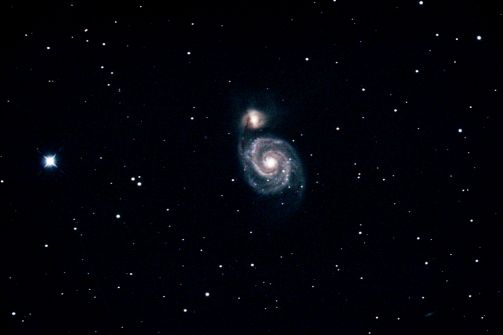
On the next night I repeated the ten exposures from the previous night and took ten flat frames using a home-made light screen on the front of the telescope. Finally 10 dark frames with the same exposure as the lights, but in total darkness.
Date and Time: 20th April 2020 21:18 to 22:13 UT
Camera: Canon 1100D
Telescope: Ritchey-Chrétien
Capture: 360 sec at ISO 800
Processing: Deep Sky Stacker using the frames in RAW (cr2) format, colours balanced manually, brightness reduced to -36 and contrast increased to 80.
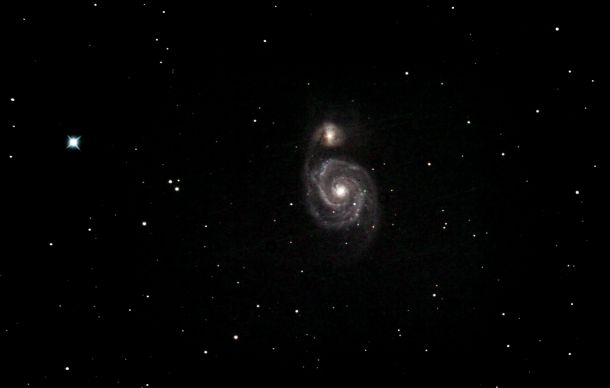
Finally, on the next clear night I repeated the pictures with the 1100D camera, but also tried to obtain pictures in Hα light using a modified D600 camera and clip-in Hα filter. The original picture here is the D1100 picture, move your mouse pointer over the picture to see the Hα picture. Now press and hold the Select key on the mouse to see the picture with the Hα merged in.
(When the Hα picture was merged with the original, the images were better aligned in Photoshop than appears here.)
Date and Time: 25th April 2020 21:39 to 22:27 UT (1100D) and 24:05 to 25:25 UT (600D)
Camera: Canon 1100D and Canon 600D modified
Telescope: 8-inch Ritchey-Chrétien
Capture: 1100D 300 sec, 10 frames;
600D 600 sec, 9 frames. Both at ISO 1600
Processing: Aligned and stacked in RegiStax5. 1100D pictures processed similarly to those on 19th April above.
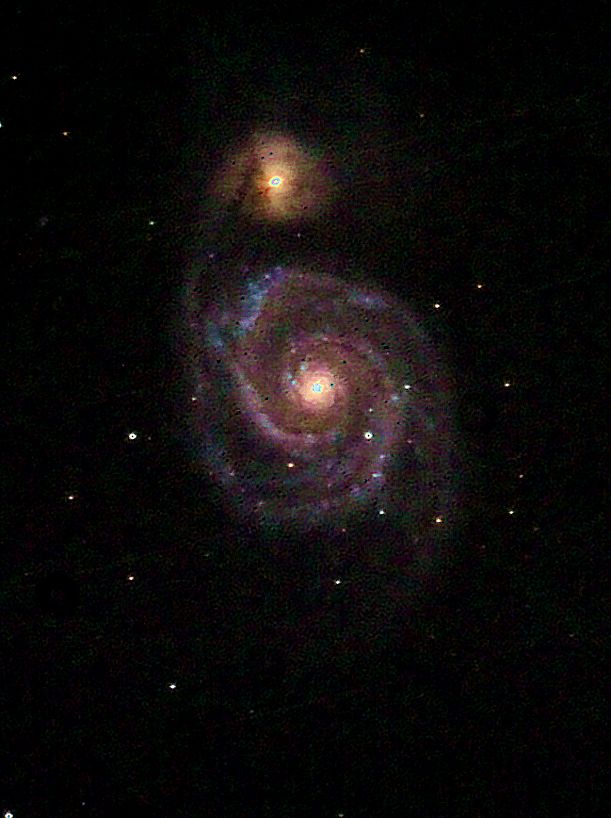
And here is an enlargement of the galaxy cut from the D1100 picture on 25th April. It has been enhanced and the colour saturation increased somewhat to bring out the subtle colours contained within the original picture. The detail in the core of the two galaxies is undoubtedly an artifact introduced in these saturated areas at some stage in the processing. I don't know at which stage, but I prefer to leave them there rather than try to remove them by pixel editing.
Date and Time: 25th April 2020 21:39 to 22:27 UT
Camera: Canon 1100D
Telescope: 8-inch Ritchey-Chrétien
Capture: 1100D 300 sec, 10 frames, ISO 1600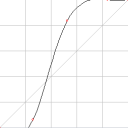 Processing: Aligned and stacked in RegiStax5, the dark frame subtracted, histogram stretched 100-255 to darken the background, gamma curve as shown here. Then the background colour was removed in PhotoImpact and the colour saturation increased to 30%.
Processing: Aligned and stacked in RegiStax5, the dark frame subtracted, histogram stretched 100-255 to darken the background, gamma curve as shown here. Then the background colour was removed in PhotoImpact and the colour saturation increased to 30%.
That ends my account of my first attempts to image M51 with a DSLR camera. Below are my much older pictures obtained, mainly, with monochrome cameras.
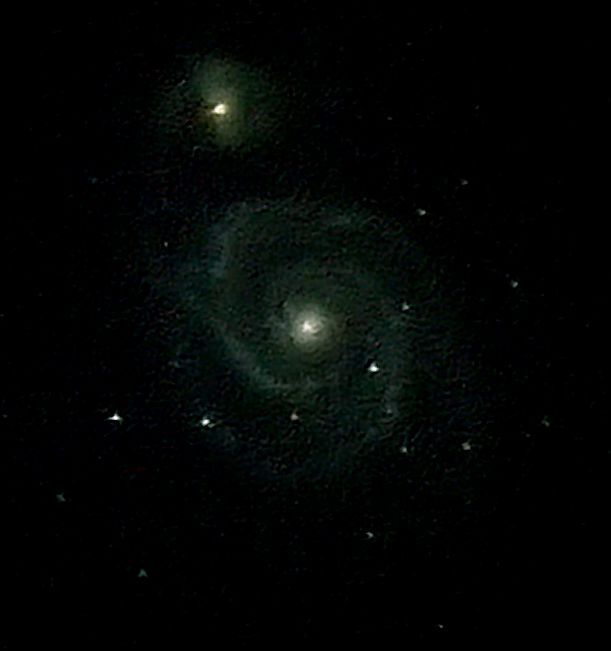
25 million years ago a supernova exploded in M51. Its light was first detected on Earth on 31st May 2011. This is a poor attempt to image this event. Unfortunately clouds prevented imaging when M51 was high in the sky and this picture was grabbed just before a tree got in the way and shortly before daybreak. To identify the supernova (designated SN 2011dh), move your mouse pointer over the image when you will see a flicker comparison of this image with the one taken two months ago which is below. Sadly the quality of this frame is not nearly as good as the older one but you can see that a new bright star has appeared below and to the left of the core of M51.
Date and Time: 8th June 2011 01:37 UT
Camera: Canon 1000D
Telescope: LX200-10
Capture: 180 sec at ISO 1600
Processing: Similar to, but somewhat more aggressive than, the image below.
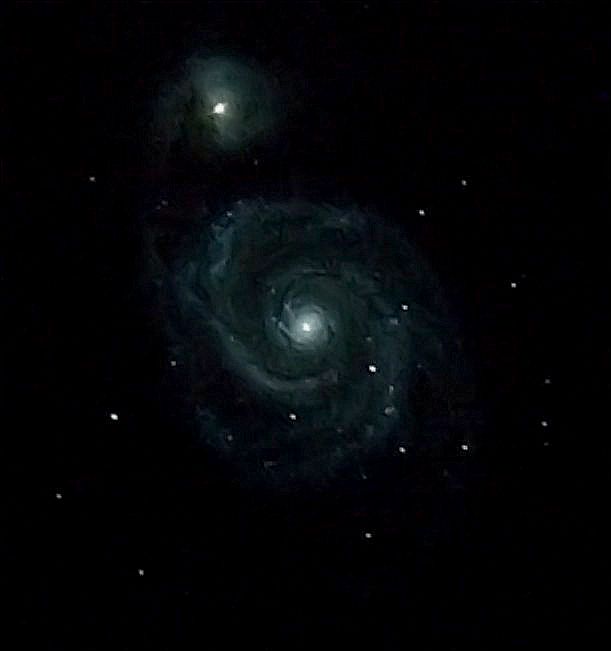
I have been impressed by the quality of pictures obtained by others with DSLR cameras. So here is my attempt at a relatively easy subject. It needed a lot of processing to remove the local light pollution, enhance the weak image, and remove the noise.
I am a little concerned that I have overdone the wavelet processing in RegiStax, so the image without that processing can be seen by moving your mouse pointer over the image.
Date and Time: 11th April 2011 01:34 UT
Camera: Canon 1000D
Telescope: LX200-10
Capture: 180 sec at ISO 1600
Processing: PhotoImpact: Removal of light-pollution, reduction to 40%, unsharp mask 1,50, brightness 40, contrast 40, gamma 1.4.
Focus Magic: Removal of slight motion blur.
PhotoImpact: Gausian blur radius 2
Noise reduction in Noiseware (free edition)
RegiStax6: Gamma 1.3, brightness -10, Gaussian wavelets 1(0.1,0.07)=100, 2(0.15,0.1)=50.
(Note on Gaussian wavelets. These are rather more complicated than the default wavelets, and this has become even more so in RegiStax6 where each wavelet has two parameters associated with it as well as the enhancement factor. I am unsure how to indicate these factors briefly above. The numbers in brackets are the two parameters, denoise and sharpen, and the number after the = is the enhancement factor. It is also possible to link the wavelets, but I did not use that feature here.)
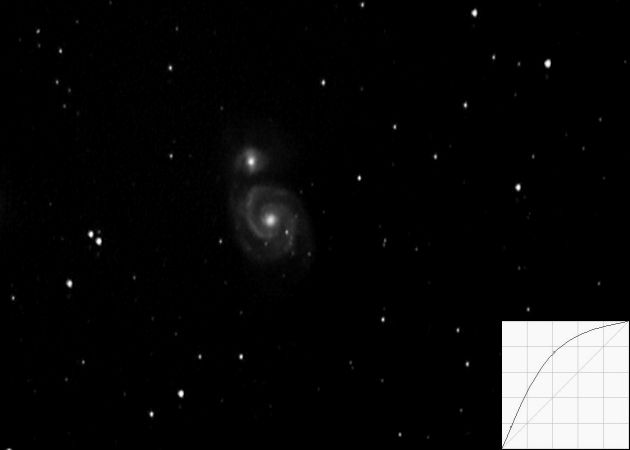
It has taken two years, but here is a much improved picture of M51 taken through my ST80 refractor. It was taken by my Starlight Xpress MX716 monochrome camera. The picture was taken through some thin high cloud, but has worked out quite well.
Date and Time: 12th April 2010 between 22:36 and 22:55 UT
Camera: MX716 in high-resolution mode
Telescope: ST80 with Orion Skyglow and IR-block filters
Capture: Star-mx7. 90", 11 frames plus 3 dark frames
Processing: Starmx7: Non-linear stretch factor 25, and dark adjustment.
RegiStax5: 11 frames stacked, gamma (see insert).
Focus Magic: Radius 4, factor 100
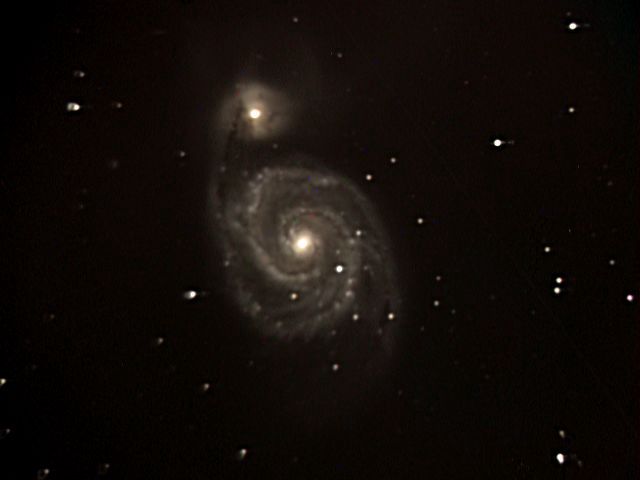
The nights of 29 and 30 May 2009 were exceptionally clear so I used them to capture M51 in LRGB with my Starlight Xpress MX716 camera in high-resolution mode.
The mouseover picture is the luminance image from which the LRGB was made (not quite aligned correctly - that was done in the final stage of processing).
Date and Time: 29th and 30th May 2009 between about 22:00 and 01:00 UT
Camera: MX716 in high-resolution mode with Astronomik filters
Telescope: LX200 with 0.33 focal reducer
Capture: Star-mx7. 60", 20 frames each of L,R,G,B, plus 5 dark frames
Processing: Initial alignment in K3CCDTools. One frame from each colour used to make the RGB image. LRGB made in Photoshop. Final adjustments to brightness and gamma in PhotoImpact.
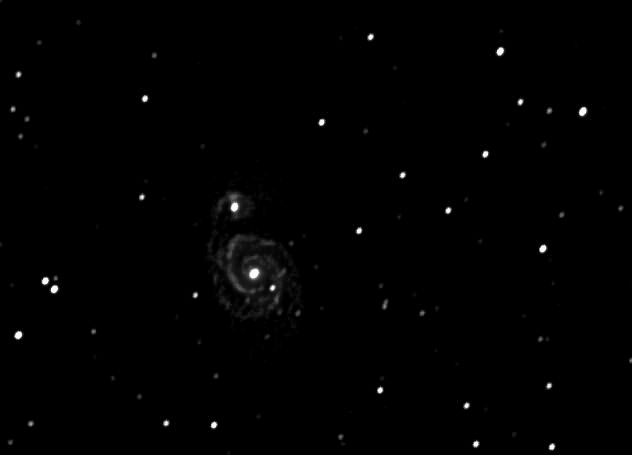
My fourth attempt at M51. Here I used my ST80 refractor and my new Atik 16ic colour camera. The shoter focal length means I have a wider field of view showing M51 against the foreground and background stars. This was one of the first times I had used this camera and I was having difficulties with the focussing. This picture is in fact slightly out of focus and I have tried to hide this by over-enhancing it. So it is not a good picture and I hope that one day I can replace it with a better one.
Date and Time: 9th February 2008 00:53 to 01:30 UT
Camera: Atik 16ic colour
Telescope: Skywatcher ST80 refractor
Capture: Artemis Capture. 180", 13 frames.
Processing: K3CCDTools. 12 frames stacked. Histogram stretched 16-80, unsharp mask 5 pixels factor 100
PhotoImpact. Gamma 1.2, unsharp mask 5 pixels factor 100, brightness -5.
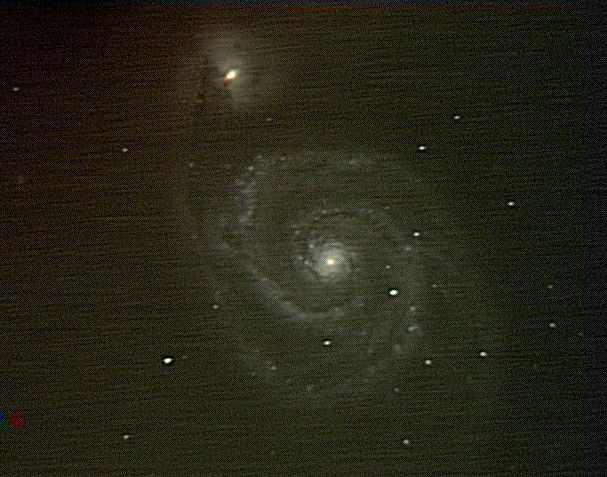
My third attempt at M51, this time using the LRGB technique. Four AVI files were collected, one (L) through a simple IR-block filter, and three (R, G, B) through red, green, and blue Astronomik filters, and using my monochrome, raw-modified Atik ATK 1-HS camera. Conditions were particularly good; the night was clear and steady and M51 was almost overhead. There is not a lot of colour in the image, but you can compare with the L image used to create it by moving your mouse over the picture.
Date and Time: 18th April 2007 23:19 to 24:22 UT
Camera: Atik 1-HS with Astronomik filters
Telescope: LX200 with 0.33 focal reducer
Capture: K3CCDTools. High gamma, 25", 57% gain, 50 frames (L), or 85% gain 25 frames (RGB), plus 10% dark frames
Processing: K3CCDTools. All frames stacked. L image, histogram stretched 25-180, unsharp mask 3 pixels factor 200
Registax. Gamma 1.3, brightness -10.
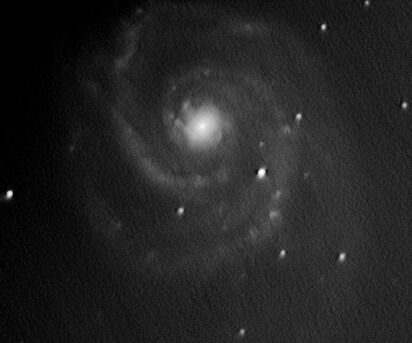
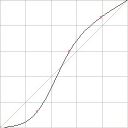
My second attempt at M51. The picture was made by taking 45 frames and 5 dark frames and stacking them in K3CCDTools. I then stretched the histogram to various extents (between 0-80 and 0-160), saved these images before recombining them. This image was then imported into Registax where the gamma curve was adjusted to a sigmoid shape to produce better contrast in the spiral arms without brightening the background too much or saturating the brighter parts. Finally some tweaking of the brightness and contrast and a passage through NeatImage, to reduce the noise, produced this final image.
Date and Time: 25th April 2006 23:00 UT
Camera: ToUcam 840K SC1
Telescope: LX200 with 0.33 focal reducer
Capture: K3CCDTools. High gamma, B/W, 60", 57% gain, 45 frames and 5 dark frames
Processing: K3CCDTools. 44 frames stacked. Histogram stretch (see above).
Registax. Gamma (see diagram), brightness -30, contrast 110.
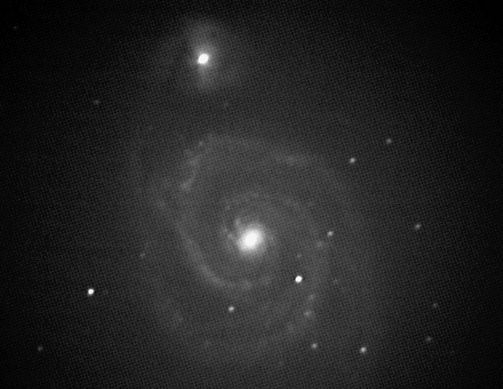
My first attempt at M51. The picture was made by taking 70 frames and 7 dark frames and stacking 59 of them in K3CCDTools. I then stretched the histogram 0-100, and finally adjusting the contrast, brightness, and gamma in PhotoImpact.
Date and Time: 4th April 2004 21:13 UT
Camera: ToUcam 840K SC1
Telescope: LX200 with 0.33 focal reducer
Capture: K3CCDTools. High gamma, B/W, 30", 95% gain, 70 frames and 7 dark frames
Processing: K3CCDTools. 59 frames stacked. Histogram 0-100.
PhotoImpact. Brightness -25, contrast 20, gamma 1.3.
Home Back to DSOs